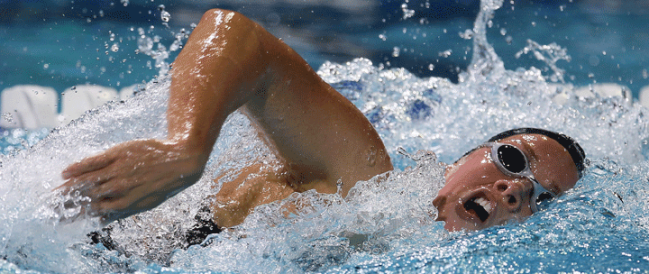|

Welcome TCSC Swimmers!!


ABCS OF MENTAL TRAINING
R is for Resiliency
BY Aimee Kimball, PhD//Mental Training Consultant
Mental toughness is as much about our reaction to an event as it is our preparation for that event. There
are going to be times when your race doesn’t go exactly as planned. There are going to be times when you fail, you struggle,
or you have to return from injury. This newsletter focuses on resiliency, a necessary mental skill that can help you to cope
with the obstacles sport and life throw at you.
Mental toughness is as much about our reaction to an event as it is our preparation for that event. There
are going to be times when your race doesn’t go exactly as planned. There are going to be times when you fail, you struggle,
or you have to return from injury. This newsletter focuses on resiliency, a necessary mental skill that can help you to cope
with the obstacles sport and life throw at you.
So what is resiliency?
The
best way to demonstrate the concept of resiliency is by using a rubber band. Take a rubber band and stretch it as far as you
can. Now release the tension. After being stretched, it returns back to the form it started in, loose and ready to be stretched
again. This is what resiliency is. It’s the ability to bounce back to where you started after your limits are tested
or if you’ve been stressed in some way. In golf, they have a statistic to measure a player’s ability to be resilient.
They call it the “bounce back.” Basically, they look at times when a golfer shoots over par on a hole and then
how often he gets par or better on the next hole. Essentially, they are looking to see whether they let a bad hole affect
the next one. A good example of this in swimming is if you add time in one event how often you are able to drop time in the
next event. Ask yourself, “If I swim poorly in one race, do I let this carry over to the next one, or am I able to ‘bounce
back’ and reset my mentality?”
How do I become more resilient?
I
have a friend we call “Teflon,” because any problem he faces never seems to stick. Something bad can happen and
he acts like it never affected him. Not everyone is so impervious to stress. Resiliency is a skill that can be learned. One
way to become more resilient is to be realistic rather than making everything a reality-show-caliber drama. That is, a bad
race is not the end of the world. You will live to race another day. Yes, you are disappointed, as any competitive person
should be. You may not have qualified for a bigger meet, or maybe you feel like your hard work didn’t pay off. Regardless
of how you feel at that moment, make sure those feelings are based in reality. All that happened is you didn’t do as
well as you wanted in a swim meet.
Let’s assume, though, that the event was important and you can’t
just brush it off as easily as you would like to. If this is the case, it’s helpful to have an established post-race
routine that allows you to assess how things went and why you succeeded/or failed, and that allows you to put that race behind
you and refocus on the next one. For example, after a race, regardless of the outcome you may want to make a habit of asking
yourself three questions, 1) what did I do well?, 2) what can I improve on for next time?, and 3) what is my physical and
mental plan for my next event? These questions allow you to realistically assess the last race and make sure you know your
plan for your upcoming event.
Another way to recover from an unsuccessful performance is to examine how you
attribute success and failure. Some people may swim a great time and attribute it to luck or win a race and believe it’s
because they weren’t competing against anyone good. Make sure if you have success you know that you are the cause of
this success and give yourself credit for working hard and swimming well. If you have a poor race and think there is never
going to be anything you can do to get better, or lose and believe it was entirely your fault (rather than crediting competitors),
it will be difficult for you to bounce back for the next event. It’s important to be optimistic and to understand that
even though you may have “failed,” a new race is a clean slate. You have control over your own performance, and
that there is always something you can do to improve.
Finally, to be resilient you need to be confident in yourself
and your hard work. Believe that you are good and be optimistic that all of the hours you log in the pool will pay off.
Resilience is simply readjusting
Whether it’s after a poor performance, an injury, or any
other obstacle from which you are trying to mentally or physically recover, remember that all it takes to be resilient is
to readjust your mindset. You may have suffered a setback, but you have the ability to view this setback as a challenge that
can make you stronger, more motivated and mentally tougher. Instead of telling yourself you failed or that you will never
recover from the situation, simply remind yourself that you can take control over what happens in the future but can’t
go back and change the past. Once the milk is spilled you can’t unspill it, but you do get to choose to either cry about
the mess or grab a paper towel and clean it up.
Make it great!
HERE IS A HELPFUL NUTRITION ARTICLE FROM USA SWIMMING......

FUELING YOUR STROKE
Six 200’s descending on five minutes. Twenty-five
50’s on :58. Whatever your “favorite,” every set during every workout and dryland session requires energy.
Nutrients
are the “chemicals” that supply the body with energy. Carbohydrate, protein and fat supply energy in the form
of calories. These are your “Energy-Yielding Nutrients.” Vitamins, Minerals and Water don’t supply energy
in the form of calories, but their presence is required in order for the body to access the energy provided by carbohydrate,
protein and fat.
During exercise, the body gets its energy primarily from carbohydrate and fat. It likes to save protein
for other things (building and repairing muscle tissue, hormones and red blood cells, and supporting the immune system). The
only time the body uses protein as an energy source during exercise is when carbohydrate and fat are not present in sufficient
quantities. This happens when the total caloric intake is too low over a period of months, and or the bout of exercise is
so long that the body’s accessible sources of carbohydrate and protein become exhausted. Neither of these scenarios
is desirable for swimmers.
Think about money. When you have lots of it, you don’t mind paying full price for
things. But when money is scarce, or there is just too much you have to buy, you look for bargains. You’re not being
cheap, just thrifty. Simplified to some extent, your body knows how to shop.
Now instead of dollars, think of your
currency as oxygen. When swimming is “easy,” say during warm-up or your easiest sets, there is plenty of oxygen
available to support the exercise. The body perceives itself as “rich” and doesn’t mind splurging on fat
(1 gram of fat costs 9 oxygens). In fact, it automatically does so because it knows it might need carbohydrate at a later
time.
When exercise is hard (we’re talking tough sets, definitely your hardest sets), oxygen is
not plentiful. In fact, the body needs every bit it can get to support the exercise, but even that is often not enough,
and the body is forced to derive energy in ways that do not require oxygen (i.e. anaerobic metabolism). In this situation,
the body perceives itself as very “poor” and becomes very thrifty with its “purchase” if fuel. Since
carbohydrate costs less than fat (1 gram of carbohydrate costs 4 oxygens), the body chooses to rely primarily on carbohydrate
for its energy.
Keep in mind that this entire fuel burning process is never a case of “all or none.” In
other words, the body is always using some combination of carbohydrate and fat, but the intensity of the
exercise dictates which fuel source will be the dominant one. When swimmering is easiest, fat is the primary fuel source.
When swimming is toughest, carbohydrate is the primary fuel source. When swimming is about 50% of maximum effort, carbohydrate
and fat contribute about equally.
Let’s face it – the majority of workouts are hard. Above 50% for certain.
If you consider the typical swim workout, it’s pretty safe to say that the primary fuel source for swimmers is
carbohydrate.
What are the first three foods that come to mind when
we say “carbohydrate?”
1. Pasta
2. Rice
3. Bread
Each if these is excellent. But what do they
have in common? They’re all white!
One of the most overlooked sources of carbohydrate is fruit. Yes, FRUIT. Fresh,
canned, frozen, dried or juiced. No matter how you look at it, fruit is an excellent source of carbohydrate. Not only does
fruit provide carbohydrate in the form of natural sugars (versus refined sugar), the bright colors of fruits indicate that
they are also excellent sources of vitamins and minerals, including a sub-group called anti-oxidants.
You might recall
that exercise is the stimulus that leads to training adaptations. And that adaptations to training occur ONLY is you give
the body the right kinds of fuels during periods of rest.
Well, one of the side effects of exercise is the generation
of “free radicals.” Free radicals are molecules that can actually cause damage to muscle tissue above and beyond
the damage caused by exercise. The damage caused by exercise is normal. It serves as part of the stimulus for training adaptation
to take place. But damage caused by free radicals is NOT a desired part of the training process. Damage caused by free radicals
(aka “scavengers”) circulating in the bloodstream after workout can continue well into the recovery period. This
is when the body is supposed to be adapting!
Anti-oxidants “absorb” free radicals, neutralizing their effect
in the body before their damage to muscle tissue can amount to much. A diet consistently rich in fruits (and other colorful
foods, such as VEGETABLES) is apt to keep the body consistently supplied with anti-oxidants, which will assist the body in
keeping free radical formation to a minimum. This a good reason to eat lots of colorful foods during the recovery time between
workouts.
Colorful foods include, but are not limited to:
Apples, Strawberries, Blueberries, Bananas, Oranges,
Kiwi, Watermelon, Raspberries, Grapes, Mango, Papaya, Apricots, Red peppers, Broccoli, Corn, Squash, Carrots, Peas, Green
beans, Tomatoes
Colorful foods DO NOT include: Skittles, Jelly Beans, M&Ms, Mike&Ikes, Fruit Loops.
|
